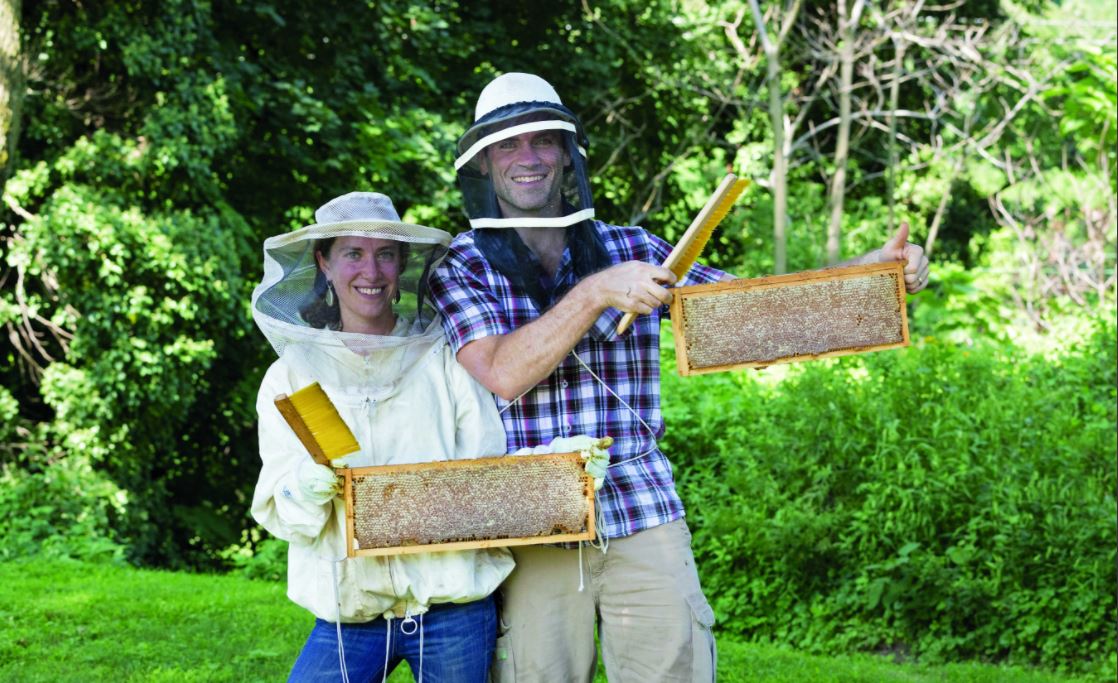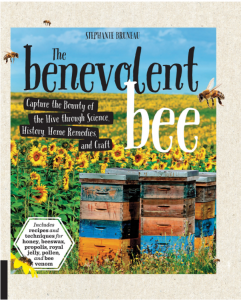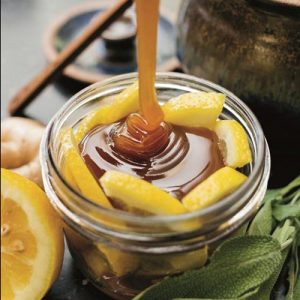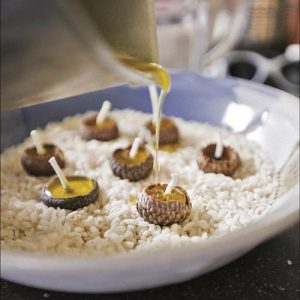WHAT’S THE BUZZ: 5 QUESTIONS FOR BEEKEEPER STEPHANIE BRUNEAU ’00

A conversation with beekeeper-herbalist-artist-entrepreneur Stephanie Bruneau ’00, author of The Benevolent Bee: capture the Bounty of the Hive through Science, History, Remedies, and Craft.
Beekeeper-herbalist-artist-entrepreneur Stephanie Bruneau ’00 runs The Benevolent Bee, a small business specializing in hive-derived products including honey, beeswax candles, and herbal body care products. At Wesleyan, Bruneau majored in the Science in Society program, where she focused on environmental science and sociology, exploring how fields of science, particularly the environmental sciences, are presented to, understood by, and acted on by our community at large.
In her new book, The Benevolent Bee: Capture the Bounty of the Hive through Science, History, Remedies, and Craft, Bruneau explores the six products of the honeybee hive—honey, pollen, propolis, royal jelly, beeswax, and bee venom—explaining why and how bees make these products, showing how humans have used them throughout history, and shedding light on how today’s beekeepers harvest the products. She also shares her favorite DIY recipes for bee-based health and wellness, body care, nutrition, and craft products. Scroll down for two of the many recipes featured in the book!
Bruneau lives in Pennsylvania with her husband, Emile, and their two young children.
What prompted your interest in bees in general and in beekeeping?
Just like a painter is drawn to a blank canvas, or a musician to a particular instrument, I have always been drawn to the natural world, and to bees in particular! My interest in beekeeping is the draw to a hands-on relationship with these fascinating creatures. When I am with the bees, I am calm and peaceful, hopeful, and totally at ease.
Can you tell us about your apiary? When did you decide to start it and why?
I keep my bees at the West Laurel Hill Cemetery in Bala Cynwyd, Penn., which is a fabulous place that we all love (the bees and my family, alike). They are committed to sustainability, and hosting our bees is part of this effort—in addition to other cool sustainability initiatives, like renting goats to control their invasive plants and owning a solar-powered lawn mower. We also have bees on top of the Weavers Way Coop in Chestnut Hill, Penn., and at the Miquon School in Conshohocken, Penn., and one more hive at home. Last week was “Pet Week” at my kids’ summer camp. The camp counselors asked all the kids if they had any pets at home. Our kids—Clara, 5, and Atticus, 3—reported that they have 10,011 pets. The counselors thought they were joking, but it’s true. Our home observation bee hive—behind plexiglass on the wall of the living room—has about 10,000 bees. Then we have our cat, Neko-Midnight; Fred the guinea pig; five chickens (Moptop, Cinnamon Queen, Doe-a-Deer, Chocolate, and Chocolate Milk); and four fish (who have no names).
 Do you have a favorite bee-based product?
Do you have a favorite bee-based product?
My favorite bee product is a toss-up between them all, but of course, I love honey. Who doesn’t?? My husband, Emile, travels a lot for work, and brings home a jar of honey from wherever he goes. We have honey from Palestine, South Africa, Japan, France, and more, all open on our kitchen counter. Each honey is a taste of the flowers blooming in each of those different places. Just like a lavender flower smells different from a rose, different flowers that grow in different places have unique scents and smells and chemical properties that are transferred to the honey through the nectar. It’s a very sweet way of traveling!
Most people have at least some rudimentary knowledge of honey and pollen, but could you briefly explain the six products you cover in the book?
The Benevolent Bee includes chapters on propolis, an antioxidant and anti-microbial resin; pollen, a nutritional and immune-boosting powerhouse; honey, an ancient superfood; royal jelly, the queen bee’s fountain of youth; bee venom, a healing sting; and beeswax, the centuries-old source of golden light in dark times.
Honey is produced by honey bees from the nectar of flowering plants. Beyond its sweet taste, honey has been used for its healing properties for centuries, worldwide.
What’s the most fascinating thing you’ve learned during your time as a beekeeper-herbalist?
Bees are fascinating creatures. Did you know that the queen bee in each hive is genetically identical to the worker bees? They’re fed a different diet from worker bees their whole lives, from the time they are tiny larvae until the day they die. This different meal plan causes their physiology and behavior to develop completely differently from worker bees, despite the same genetic foundation. Queen bees are 1.5 times the size of worker bees, live three to five years—instead of three to five weeks—are sexually mature (unlike worker bees who cannot mate), and have a totally different set of behaviors from the other bees in the hive. Amazing!
 Lemon Ginger and Sage Cold and Cough Syrup
Lemon Ginger and Sage Cold and Cough Syrup
from The Benevolent Bee: Capture the Bounty of the Hive through Science, History, Remedies, and Craft
Combine honey with the healing properties in lemon, ginger, and sage and you’ve got a natural, delicious way to treat cold and flu symptoms. Sage has been used in medicine in cultures around the world for centuries. The herb is antibacterial and antispasmodic, making this syrup a great choice for a cough at bedtime. This syrup can be swallowed straight from a spoon or stirred into hot water or tea.
This recipe is very flexible. Add more ingredients for larger jars or for a stronger syrup. Try substituting orange slices for the lemon or clove for the sage (cloves are a great choice, as they are an expectorant and antiviral).
Note: Sage should not be used when pregnant or breastfeeding.
Yield: Makes 1 cup (about 200 g)
Ingredients:
1 lemon
1 teaspoon ground ginger or 2 teaspoons grated fresh ginger
6 to 8 fresh sage leaves
½ cup (160 g) honey – or enough to fill the jar.
Directions:
- Slice the lemon into thin half-moon shapes. Add half of the slices to a half-pint jar, then add half of the ginger and sage, then half of the honey.
- Using a chopstick or other long, thin object, give it a stir and move the citrus slices around to make sure the honey runs between them.
- Repeat with the remaining ingredients, then stir and top off with more honey if necessary to fill the jar.
- Within 3 to 4 hours, the honey will have drawn the juices out of the other ingredients.
- Give it a stir to combine the honey and juice. The thick honey will have transformed into a lovely syrup, which will get stronger with time.
- Store in a glass jar in the refrigerator for up to 2 months.
 Floating Acorn Cap Candle
Floating Acorn Cap Candle
from The Benevolent Bee: Capture the Bounty of the Hive through Science, History, Remedies, and Craft
Fall often finds my kids and me on our knees underneath an acorn tree, hunting with the squirrels. I have too often opened up the washing machine to discover that I forgot to empty our pockets before putting our clothes in the wash. But it’s all worth it. These very sweet floating candles are great for celebrations or gatherings. They don’t have the longest burn time (only 10 to 20 minutes, depending on the size of your acorn cap), but their whimsy is unparalleled. I particularly like using them to decorate our Thanksgiving table.
Yield: Makes as many acorn candles as you want.
Ingredients:
Acorn caps
Beeswax
Tabbed wick
Dry rice
Bowl
Double boiler
Scissors
Decorative bowl filled with water
Directions:
- Make a nest for your acorn caps using a bowl of dry rice.
- The rice will help keep the caps upright and level while you’re pouring in the wax.
- Melt the beeswax in a double boiler.
- Place a tabbed wick in the middle of each cap, and carefully pour the wax into each tiny vessel.
- It takes practice and a steady hand, but after a few caps, you’ll get the hang of it and be able to fill each cap perfectly!
- Trim the wicks with scissors.
- Float the candles in a bowl of water.
